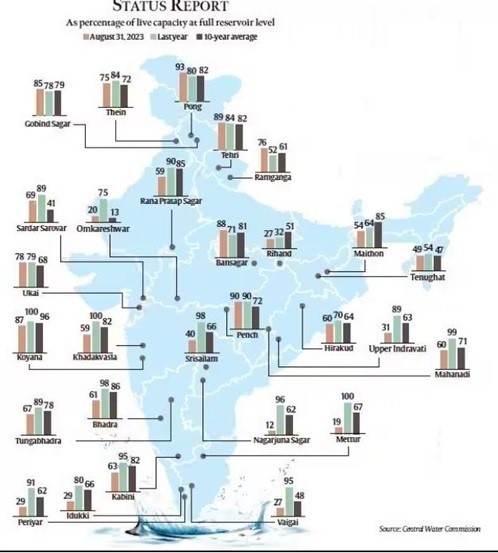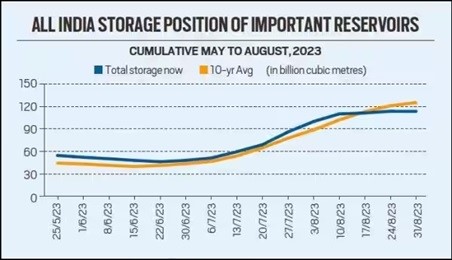Description

Disclaimer: Copyright infringement not intended.
Context
- August rainfall was the lowest in almost a century, with India receiving 36% less than typical for the month.
- August has the greatest rainfall (25.4 cm) of the four monsoon months, followed by July with 28 cm.

Details
- According to the most recent Central Water Commission (CWC) data, these 150 reservoirs around the country had roughly 113 billion cubic meters (BCM) of water, which was nearly 10% less than the normal--or average--storage at this time of year.
- The reservoirs in the southern states have the greatest shortfall, having been reduced to 49% of their original capacity.
- After July, August is usually the rainiest month. During August, the reservoir level should rise.
- The month of August 2023 was the driest in more than 120 years.
- August brought only approximately 162 mm of rain in the country as a whole, compared to the projected about 255 mm, a 36% deficit.

Temperature and precipitation In August 2023
- In August, rainfall in India averaged around 161.7 mm, compared to 191.2 mm in 2005, the previous low.
- Rainfall in Central India in August was roughly 164.5mm, compared to the previous record of 172.8mm in 1905.
- In August, the Peninsula received only 73.5mm of rain, compared to the previous record low of 89.4mm in 1968.
- August experienced a 36% decrease in rainfall, and the monsoon rainfall total (through August 31) is 10% below average.
- In August, the all-India average maximum temperature was 32.09°C, compared to the normal of 31.09°C, while the all-India average mean temperature was 28.40°C, compared to the normal of 27.55°C.
- Both were the highest for a single month since 1901. In addition, the Peninsula experienced its greatest average maximum, mean, and lowest temperatures since 1901.
Why was August one of the driest months on record?
- Monsoon rainfall in August was the lowest in 120 years, dating back to 1901, both nationally and in Central India and the southern Peninsula.
- The emergence of El Nino conditions in the equatorial Pacific Ocean was the primary cause of low rainfall activity in much of India in August, except northeastern India, the Himalayan states, and parts of Tamil Nadu.
The following are the consequences of a rainfall deficit:
- The Unexpected rise in power demand, primarily for irrigation purposes.
- Coal's share of total power generation in India increased to 66.7% in August, the highest for the month in six years.
- A lack of rain has further exacerbated the reduction in major reservoir water levels, resulting in a 21 percent shortage compared to the previous year's levels.
- Concerns have been voiced regarding lower crop output and the possibility of more export limitations as a result of the country's rice restrictions.
Significance of reservoirs
- Because approximately 75% of India's yearly rainfall falls during the four-month southwest monsoon season, these reservoirs are an important source of water supply for the rest of the year, catering not only to families and industrial usage but also to power generation.

States having the highest and lowest rainfall
- Lowest: Kerala has had 48% of its rains this season, while Manipur and Jharkhand have had 46% and 37%, respectively.
- Highest: Ladakh has the biggest excess (169%), followed by Chandigarh (61%), and Himachal Pradesh (31%).
|
PRACTICE QUESTION
Which region in India gets more rain from the northeast monsoon than the southwest monsoon? Explain.
|
https://indianexpress.com/article/explained/explained-climate/driest-august-falling-reservoirs-8928058/
https://www.reuters.com/world/india/india-faces-record-low-august-rains-threatening-summer-crops-2023-08-18/












